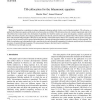Free Online Productivity Tools
i2Speak
i2Symbol
i2OCR
iTex2Img
iWeb2Print
iWeb2Shot
i2Type
iPdf2Split
iPdf2Merge
i2Bopomofo
i2Arabic
i2Style
i2Image
i2PDF
iLatex2Rtf
Sci2ools
84
Voted
AES
2005
Springer
2005
Springer
TH-collocation for the biharmonic equation
This paper is intended as a contribution to enhance orthogonal collocation methods. In this, a novel collocation method--TH-collocation--is applied to the biharmonic equation and the merits of such procedure are exhibited. TH-collocation relaxes the continuity requirements and, for the 2D problems here treated, leads to the development of algorithms for which the matrices are sparse (nine-diagonal), symmetric and positive definite. Due tothese properties,the conjugate gradient method can be directly, and more effectively, applied to them. These features contrast with those of the standard orthogonal spline collocation on cubic Hermites, which yields matrices that are non-symmetric and non-positive. This paper is part of a line of research in which a general and unified theory of domain decomposition methods, proposed by Herrera, is being explored. Two kinds of contributions can be distinguished inthis; some that are relevant for the parallel computation of continuous models and new di...
AES 2005 | Collocation | Cryptology | Orthogonal Collocation Methods | Orthogonal Spline Collocation |
Related Content
| Added | 15 Dec 2010 |
| Updated | 15 Dec 2010 |
| Type | Journal |
| Year | 2005 |
| Where | AES |
| Authors | Martín Díaz, Ismael Herrera |
Comments (0)

